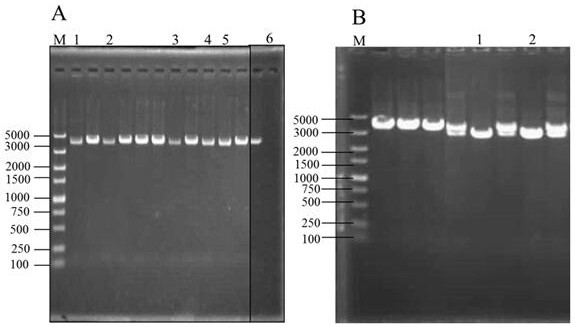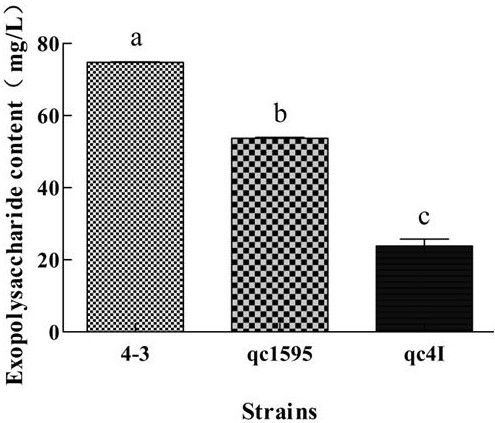Application of glycosyltransferase gene
A technology of glycosyltransferase and gene, which is applied in the field of microbial gene function and application, can solve the problems of poor strain stability, high extraction and purification costs, and low EPS synthesis, and achieve the effect of improving screening efficiency
- Summary
- Abstract
- Description
- Claims
- Application Information
AI Technical Summary
Problems solved by technology
Method used
Image
Examples
Embodiment 1
[0029]Example 1: Glycosyltransferase gene (orf 1595、cps 4I) Knockout homology arm clone
[0030]1. PCR amplification of the upstream and downstream homology arms
[0031]Use TAKARA bacterial genomic DNA extraction kit (Bao Biological Engineering Co., Ltd.) to extract the food-borne Lactobacillus plantarum YM 4-3 genome, and the specific operation is carried out according to the kit instructions:
[0032]Targeting genesorf 1595, using the extracted genome as a template, usingorf 1595-up-F (5’-CCGGAATTC GATGGATCTAAAGCGGTGTT-3’ underline is the restriction siteEcoR Ⅰ),orf 1595-up-R (5’- CGCTGAATGAATTGCCTTTGTGCCGCATGTATTTGTAAGG-3’) andorf 1595-down-F (5’- CCTTACAAATACATGCGGCACAAAGGCAATTCATTCAGCG-3’),orf 1595-down-R(5’-CCCAAGCTT GTGGCAAGCCGTCAACGA-3’, underlined is the restriction siteHind Ⅲ) Amplify to get upstream and downstream homology armsorf 1595-up (992bp),orf 1595-down (1156bp);
[0033]Targeting genescps 4I, using the extracted genome as a template, using primer pairs respectivelycps 4I-up-...
Embodiment 2
[0040]Example 2:orf 1595、cps 4I gene single knockout vector construction
[0041]Use restriction enzymesEcoR Ⅰ.Hind Ⅲ andEcoR Ⅰ.Hind Ⅲ Simultaneous restriction digestion of the correctly sequenced gene knockout fragment and temperature-sensitive plasmid pFED760;orf The 1595 restriction digestion system is:EcoR Ⅰ, 2µL;Hind Ⅲ, 2µL; 1× H buffer, 4µL; gene knockout fragment or pFED760, 10~16µL; add sterile deionized water to 20µL.cps The 4I digestion system is:EcoR Ⅰ, 1 µL;Hind Ⅲ, 1 µL; 1× M buffer, 4 µL; gene knockout fragment or pFED760, 30 µL; add sterile deionized water to 40 µL. After digestion at 37°C for 4 hours, the digested product was recovered. According to the target gene: vector = 4:1~2:1 (molar ratio), after loading the sample, add T4 DNA ligase and ligate at 16°C for 12-16 hours; use heat shock transformation method The ligation product was introduced into E. coli DH5α competent cells, and then spread on the erythromycin-LB solid plate; after overnight culture at 28°C, the...
Embodiment 3
[0042]Example 3:orf 1595 orcps Construction of 4I gene knockout strain
[0043]1,orf 1595 orcps Introduction of 4I gene knockout vector into competent cells of Lactobacillus plantarum
[0044]Prepare Lactobacillus plantarum competent cells according to the method reported by Fei Yongtao (2015, South China University of Technology master's thesis); add 10μL gene knockout vector pFED760-Δ to 90~100μL Lactobacillus plantarum competent respectivelyorf 1595 or pFED760-Δcps 4I, mix gently, transfer to the pre-cooled electroporation cup after ice bath for 5 minutes, and perform the electroshock according to the parameters of 1.25kv / cm, 200Ω; after the electroporation is completed, quickly add 900μL of fresh MRS culture medium to the electroporation cup, and use the pipette tip After gently pipetting and mixing, transfer the mixed solution to a sterile 1.5mL centrifuge tube and incubate at 28°C for 2.5~3 hours to recover the cells. After culture, the bacterial solution was centrifuged at 8000 rpm...
PUM
 Login to View More
Login to View More Abstract
Description
Claims
Application Information
 Login to View More
Login to View More - R&D
- Intellectual Property
- Life Sciences
- Materials
- Tech Scout
- Unparalleled Data Quality
- Higher Quality Content
- 60% Fewer Hallucinations
Browse by: Latest US Patents, China's latest patents, Technical Efficacy Thesaurus, Application Domain, Technology Topic, Popular Technical Reports.
© 2025 PatSnap. All rights reserved.Legal|Privacy policy|Modern Slavery Act Transparency Statement|Sitemap|About US| Contact US: help@patsnap.com



